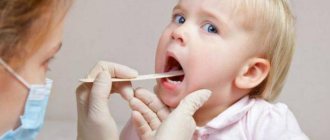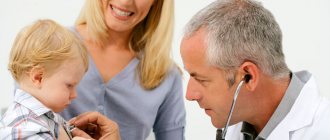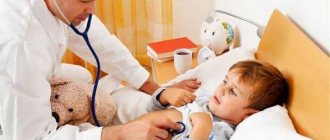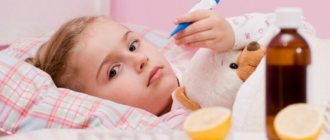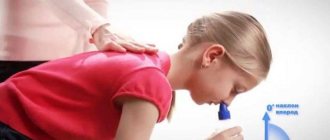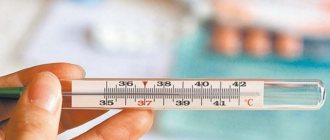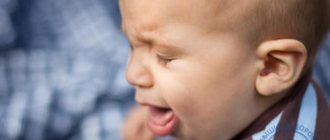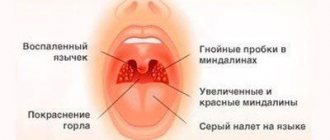What to do when a child has snot and cough and fever
Typical view of a sick child.
In this article we will talk about what parents should do when their child has snot, cough and fever. In the autumn-winter period, the baby’s body is often susceptible to infection with acute respiratory diseases.
Children with reduced immunity are especially at risk. Viral infections are transmitted mainly by airborne droplets. Every mother can confidently recognize the first signs of the disease when a cough, snot, and fever are clearly evident in the child.
How to recognize that a child is sick
Let's look at what diseases these three symptoms appear in:
| Diseases | Cough | Runny nose | Temperature |
| Acute rhinitis | — | + | + |
| Acute pharyngitis | — | + | + |
| Acute tracheitis | + | + | + |
| Acute bronchitis | + | + | + |
| Bronchopneumonia | + | + | + |
| Allergic rhinitis | — | + | — |
| Foreign body aspiration | + | — | — |
| Bronchial asthma | + | + | + |
| Cystic fibrosis | + | + | — |
| Inhalation of irritating substances (various gases, dust, toxic substances) | + | + | — |
| Stenosing laryngotracheitis | + | + | + |
| Tuberculosis | + | — | — |
Every viral infection usually begins with illness. The child becomes lethargic and capricious. The most common symptoms of a viral infection are a child's cough, snot, and fever.
But, under the mask of a viral infection, a serious illness can also be hidden. So, if everything is not so scary, and your child has a banal viral infection, then you will notice clear mucous discharge from the nose. When pathological microorganisms attach, the mucus becomes greenish in color.
When the inflammatory process descends lower to the bronchi, the child develops a cough. At first, the cough may be dry (see
A child has a constant dry cough: it’s time to worry), then when a certain amount of sputum is produced, the cough becomes wet.
If the process is rapidly developing, the doctor may use a special instrument called a phonendoscope to listen to your child's wheezing in the lungs.
The temperature in infectious diseases of the upper respiratory tract is sharp, abrupt and often reaches high levels, usually above 38 degrees Celsius. It is difficult to reduce with antipyretic drugs. Therefore, when a cough, snot, or fever appears in a child, you should immediately consult your pediatrician about treatment tactics.
A doctor listens to wheezing in a sick child.
How to distinguish an important cough from a dry one
Many mothers ask the question: how to determine what kind of cough a child has?
Let's look at the distinctive features in the table:
| Moist cough | Dry cough | |
| What diseases does it occur in? | Acute respiratory diseases, bronchopneumonia | Whooping cough, Bronchial foreign body, Inhalation of irritants, Tuberculosis, Bronchial asthma |
| Characteristics of cough | When you cough, a large amount of mucus is produced | A cough that tears at the throat (see Ringing throat and dry cough: choosing what to treat). Often the child complains that it hurts to cough |
| When does a cough occur? | Usually changes from dry to wet within a few days of the onset of the disease. | In the first days of illness |
| Main cause of cough | Large amount of sputum | Inflammation |
| Amount of sputum | A lot of | Almost not |
| Treatment tactics | Expectorants that facilitate the removal of mucus from the lungs | Antitussives that suppress the cough center |
Additional laboratory examination methods
If there are symptoms such as cough, snot, fever in a child, then additional examination will be necessary:
- general blood analysis
- general urine analysis
- X-ray examination of the lungs.
Treatment
In a situation where a child has a temperature of 38, coughs and snot, it is necessary to immediately begin treatment.
Treatment requires a combination of several aspects:
- Medications
- Physiotherapeutic procedures
- Traditional medicine methods
Drug treatment
Since fever, cough, snot most often occur with viral infections, the prescription of antiviral drugs is mandatory (see If a child starts coughing - how to treat it). Now the pharmaceutical industry and TV advertising are simply replete with a variety of drugs from this group.
The price and effect of such drugs vary. Drugs in this group will help the body shorten the duration of the disease and avoid numerous complications.
For coughs, expectorants are prescribed. There are different medications for dry and wet cough!
For wet coughs, medications are used to facilitate sputum discharge, for example:
- Ambrobene,
- ACC,
- Mukaltin and others.
But for a dry cough, drugs that suppress the cough reflex are needed, for example: Libexin, etc.
Inhalations with expectorant or anti-inflammatory solutions have a good effect. A doctor will help you decide on the choice of treatment.
When you have a runny nose, you need to rinse your nose with physiological solutions as often as possible; in particular, you can use Aqualor or Aquamaris. This procedure allows you to clean the nasal cavity from pathogenic microorganisms and dust particles.
Important! Rinsing in children is carried out in the absence of nasal congestion, that is, if the child has a fever, cough and snot, but at the same time he can breathe freely.
Otherwise, all the inflammation will spread to the ear and a complication will develop in the form of otitis media.
Prescribing vasoconstrictor drugs for children under one year of age is strictly contraindicated! After the nasal rinsing procedure, it is advisable for older children to blow their nose, and for younger children to remove the remaining mucus and rinsing liquid with an aspirator.
In pediatric practice, fever is reduced with two approved drugs - Ibuprofen and Paracetamol. Can be used in the form of tablets, suspensions and rectal suppositories.
Physiotherapeutic treatment
Physiotherapeutic procedures are indicated if the child has snot and cough with a temperature of 35.
Appointed:
- UV irradiation of the throat, nose,
- chest electrophoresis,
- heat therapy.
ethnoscience
Traditional medicine methods will be very effective for symptoms such as fever, cough, snot (see.
How to cure a cough at home: the best recipes), for example, rubbing with badger fat, applying mustard plasters and cupping.
But they refer to auxiliary treatment methods or, in other words, to distracting procedures. Together with the main treatment, they, of course, have a positive effect.
Also don't forget! If a child has a cough and snot, the temperature in the room where he is located should be cool (not higher than 20 degrees Celsius) and humid. If you don't have a special hygrometer to measure air humidity, you can simply place a small container of water in the room. The daily volume of liquid drunk by a child should be 1-1.5 liters per day.
It could be:
- plain water,
- juices,
- compotes,
- fruit drinks.
The apartment must be ventilated frequently. You can also use various oils to disinfect indoor air. Such oils include Thuja aromatic oil or the “Breathe” oil mixture.
The photo shows a spray from the “Breathe” series.
Prevention
Firstly, you need to try to exclude contact with sick people. If you notice that someone else's child has a runny nose and a cough with a temperature of 38, then the likelihood that your baby will get sick over the next three days is very high. Therefore, start giving your child antiviral drugs as early as possible and increase vitamin C in your baby’s diet (for example, rosehip decoction).
Now you know what to do if your child has snot, cough and fever. But remember! Each drug mentioned in this article can only be used as prescribed by a doctor. Each drug purchased at the pharmacy comes with instructions that must be strictly followed! Next, you can watch the video in this article.
Source: https://Kashel.su/simptomy/u-rebenka/u-rebenka-sopli-i-kashel-i-temperatura-64
Causes of rhinitis and how to treat a runny nose
A child’s temperature without cough and snot is not a good indicator. It is better to make an appointment at the clinic. With a runny nose, everything is much simpler; you just need to put drops in your nasal passages to clear them of mucus and make breathing easier.
What will the pediatrician prescribe if a child has symptoms of high fever and snot? The recipe will definitely contain an antipyretic agent and drops:
- Salin is prescribed when a baby has a runny nose with fever. This is an antiviral spray, the active ingredient is sodium chloride;
- Nazoferon - a spray is prescribed when a small patient has green snot and cough. The drug has antiviral and antibacterial effects;
- Isofra is a safe spray that can be used to treat young children. Cough, snot, temperature 38 degrees Celsius - these are the main symptoms when a pediatrician can prescribe this medication;
- Delufen is an antiviral drug that also has antiallergic properties. Effective when the patient has a cold.
A runny nose in a baby (rhinitis) may appear due to a weakened immune system or too cold air outside. In this case, snot and cough may occur.
You cannot use drops for a runny nose constantly. The choice of medication is made on an individual basis. If the baby has mild congestion, the pediatrician may prescribe medications based on natural ingredients. Vasoconstrictor sprays are prescribed when a child has a cough, snot and fever.
Fever, cough and runny nose in a child: causes, treatment - Your online doctor
In children, runny nose, fever and related symptoms occur quite often.
They are usually associated with acute respiratory diseases, but such signs may also indicate other pathologies. Parents should be vigilant and after a runny nose appears in a child, it is better to contact a pediatrician.
Causes
A child's cough, fever, and runny nose most often indicate a cold caused by viral or bacterial agents.
But sometimes these symptoms can be physiological or allergic in nature, and can also indicate serious respiratory diseases.
Physiological reasons
A runny nose or accompanying symptoms can be provoked by the following physiological factors:
- inhalation of polluted air;
- foreign object in the respiratory system;
- food particles in the windpipe;
- teething
If symptoms are associated with such factors, then improvement usually occurs within 2-3 days.
Pathological causes
ARVI, respiratory pathologies or influenza are all pathological factors. In this case, viral infections are the cause of the disease. You can suspect the penetration of a viral infection by the following symptoms: tickling in the throat, rawness, low-grade fever, runny nose, cough.
Viral infection
If the baby is faced with a viral infection that penetrates the body, then his cough will be wet and productive. Such children are treated with antiviral drugs, and herbal teas are sufficient to combat cough.
Once the viruses are suppressed, the cough will go away on its own.
Allergic reaction
Any substance of natural or industrial origin that is in high concentration in the air can act as an allergen. The child’s body begins to react sharply to them when the immune status is reduced due to treatment with antibacterial agents or for other reasons.
We recommend reading: 4 features of catarrhal sinusitis. Symptoms and treatment
Allergic cough is usually characteristic of the flowering season. In addition, it is accompanied by rhinitis and a sharp increase in body temperature. But if the listed symptoms are truly caused by an allergic reaction, then they will cease to appear after the allergen is eliminated.
Respiratory diseases
Pathologies of the respiratory system are characterized by a runny nose, fever or cough, but the nature of the symptoms will vary depending on the etiology of the disease. In any case, if the cause is a bacterial infection, then the body temperature rises to 38 degrees (the high temperature lasts for several days), a runny nose appears, the baby shudders and his body aches.
The child has a cough
Main symptoms
If a child has a cough, runny nose and fever, then depending on the disease they may be supplemented by other symptoms:
- Pneumonia. Inflammation is manifested by high fever, painful and frequent cough, rapid, difficult breathing, and excessive fatigue.
- Tracheitis. Severe, paroxysmal cough that worsens at night or in the morning. There is also a runny nose and a temperature that changes all the time.
- Bronchitis. This disease rarely goes away on its own. Usually, along with it, the baby is diagnosed with rhinitis, inflammation of the mucous membrane of the trachea or larynx, and almost always the patient has a fever.
- Laryngitis. Against the background of inflammation that has affected the laryngeal mucosa, children have a hoarse voice, an unproductive cough, and a runny nose.
If diarrhea appears along with a cough, fever and runny nose, this may indicate the presence of an adenovirus infection.
How to treat
After detecting signs of illness in a child, adults should call an ambulance or take the child to see a doctor themselves. This is necessary to confirm the diagnosis and obtain reasonable treatment recommendations.
Basic Rules
After examining the baby, the doctor may release him to be treated at home, or may insist on hospitalization. The latter occurs only if severe pathologies are detected that require constant medical supervision. If the doctor has sent the patient home, then parents must adhere to the following basic rules:
- For the baby to recover, optimal conditions should be provided. The room temperature should be approximately 20 °C and the humidity should be 70%. It is recommended to regularly ventilate the room, but without creating drafts, and also regularly carry out wet cleaning.
- Review the patient's eating habits. During illness, the baby experiences hypovitaminosis, so his diet should include enough fruits and vegetables. Confectionery, fast food or other unhealthy foods should be kept to a minimum.
- Make sure that the patient takes more fluids. This is important because, against the background of a feverish state, the baby sweats a lot, and in order to avoid dehydration, it is necessary to replenish the losses. You can drink clean water without gases, herbal teas, compotes, and uzvars.
It is especially important to monitor how much fluid a baby drinks, since advanced dehydration in their case can be fatal. The volume of fluid required is calculated taking into account the severity of the disease and the age of the patient. It is also necessary to ensure that the baby gets enough sleep. This is extremely necessary for restoration of strength and speedy recovery.
Systemic treatment
For internal use the following groups of drugs can be used:
- antibacterial or antiviral;
- immunomodulators;
- antipyretic;
- antihistamines;
- cough suppressants (mucolytics and expectorants).
When children have a fever, some parents first want to give them an antibiotic, but this is not justified in all cases. If the disease is caused by a virus, then antibacterial agents will not only not help, but may even cause harm. By exerting a bactericidal effect, they further reduce immunity, and this only plays into the hands of a viral infection.
Local therapeutic effect
Systemic drugs usually have many side effects and contraindications, so they are not always used in pediatrics. If the pathology affects the nasal mucosa, timely treatment of a runny nose is carried out with local agents:
- using saline rinses;
- intranasal vasoconstrictors;
- inhalations with antiseptics or mucolytics;
- irrigating the throat with antiseptic agents.
In addition, having determined the etiology of the runny nose, pediatricians can prescribe nasal medications for children with antihistamines, glucocorticosteroids, or antibacterial components.
In order for children to experience a runny nose and fever less often, it is necessary to take care of strengthening the immune system. Along with synthetic or natural immunomodulators, such children are recommended to play sports (they can be taught breathing exercises in a playful way), hardening procedures, proper nutrition, as well as timely treatment of all acute forms of diseases.
Traditional methods
Fever, runny nose or other symptoms can also be successfully treated with folk remedies. But this can only be done after consultation with a pediatrician. The most popular recipe is black radish with sugar.
To obtain the medicine, make a 2/3 hole in a medium-sized root vegetable and fill it with sugar. Place the radish in a container for 6-8 hours to collect the secreted juice.
The finished product is given to the child 5 ml 3 times a day 30 minutes before meals.
We recommend reading: Acute and chronic sinusitis - 18 causes of the disease
Another popular remedy is burnt sugar. First, granulated sugar is fried in a frying pan and then combined with water (30 g of sugar per 100 ml of water). The finished medicine is given to the baby 5 ml 30 minutes before meals. And also to reduce the temperature, they give children tea with raspberries, black currants, and linden tea. And for a runny nose they use the juice of carrots, beets, and aloe.
Fever, runny nose and/or cough are symptoms that deserve careful attention. Self-medication is not appropriate at any age, but especially when it comes to young children.
With timely seeking medical help and well-chosen therapy, recovery will not take long.
Source:
Cough, runny nose, fever in a child: causes and methods of treating symptoms
After some time after birth, every baby inevitably develops symptoms such as fever, snot and cough.
What does this symptomatology mean in children? It means that the child’s viral disease is worsening, which must be treated immediately.
But before treating the disease, it is necessary to make an accurate diagnosis. To do this, you cannot do without the help of a specialist.
Underlying causes of symptoms
If a child has a runny nose, cough and fever, then the cause of these symptoms is viral diseases.
Such diseases occur after a viral infection enters the body, which the immune system is unable to cope with.
In this case, the child initially develops snot and a temperature of 38, after which the throat begins to sore, and the next day in the evening the baby begins to suffer from a rending cough.
It is important to know! Such symptoms indicate viral diseases, but to determine a more accurate diagnosis, you need to go to the hospital to see a specialist. This is necessary so that the doctor examines the baby and determines the exact disease.
If a baby develops a respiratory disease, then the temperature rises to 39 degrees. A high temperature lasts in children with respiratory diseases for no more than 3-4 days. Fever, as well as a cough and runny nose in a child indicate that a viral disease is developing. In addition, the following additional symptoms will help confirm this diagnosis:
- nasal congestion;
- lack of appetite;
- sleep disturbance;
- lethargy and passivity;
- nervousness.
A wet cough indicates that the patient has signs of respiratory tract damage. If, during the examination of the neck, the doctor finds signs of redness of the mucous membrane, he will prescribe appropriate treatment. At the beginning of the disease, a dry cough develops, which turns into a wet cough after a day. A wet cough indicates that mucus is being coughed up from the lungs.
Why is treatment prescribed for colds? A severe cough, runny nose and high temperature must be treated for the reason that the disease can develop into a complex form, causing complications such as bronchitis, pneumonia, chronic rhinitis and other pathologies.
It is important to know! If your baby exhibits symptoms such as snot, cough and high fever, you should immediately show him to a specialist.
Why do colds cause symptoms of cough, runny nose and high fever?
Acute respiratory and viral ailments include such types of diseases as influenza, parainfluenza, adenoviral and enteroviral diseases, as well as acute respiratory viral infections and acute respiratory infections. Why do these types of illnesses provoke snot, fever and cough in a child?
When a virus enters the body, it does so primarily through the respiratory system.
The virus helps provoke irritation of the mucous membrane, resulting in the occurrence of inflammatory processes.
These processes form in the nose, resulting in a severe runny nose, in the bronchi, which contributes to coughing. Why does body temperature rise?
After the virus penetrates, the body recognizes it as a foreign object and seeks to neutralize it using all possible methods. This is a normal reaction of the body, therefore, when the process of fighting the virus is activated, hyperthermia occurs.
Based on the readings of the thermometer, you can understand how strong the viral infection that has entered the body is. Usually, with viral illnesses, a child develops a temperature of 38, but it cannot be ruled out that it can rise to 39 or even 40 degrees.
It is important to know! Temperatures above 38.5-39 degrees in children and adults must be brought down with the help of antipyretic drugs. For children under one year of age, it is necessary to reduce hyperthermia when the thermometer reading reaches 38.5 degrees.
Source: https://cgb-vuf74.ru/medicamenty/temperatura-kashel-i-nasmork-u-rebyonka-prichiny-lechenie.html
Medications
If you can’t get by with improvised means alone, the runny nose gets worse, the mucous membranes swell and nasal breathing becomes very difficult - parents are faced with a dilemma: to use or not to use vasoconstrictor drugs. After all, the effect of these drugs is obvious, but there is a danger of complications.
So, a runny nose in a two to four year old child – how to treat it? And how justified is the use of decongestants (vasoconstrictor drops) to facilitate nasal breathing? It should be noted that complications arise not because of drugs, but because of their illiterate use
. It is unacceptable to use “adult” concentrations of the drug for children or increase the prescribed dosage, as well as more frequent and prolonged use.
However, failure to use decongestants can also lead to the development of complications such as sinusitis. The fact is that all nasal sinuses (maxillary, frontal, ethmoid and sphenoid) open with small openings into the nasal cavity. It is through these openings that the sinuses are cleansed of germs along with nasal mucus.
In children, these openings are so small that with severe swelling of the nasal mucosa, they close completely. As a result, microbes accumulate in the sinuses, which leads to acute inflammation - sinusitis.
When choosing a medicine for a child’s runny nose, you should pay attention to the active substance and its percentage (concentration) indicated on the box or in the instructions.
Active substance - "Phenylephrine"
Medicines containing phenylephrine (mesaton) are used to facilitate nasal breathing in case of influenza, hay fever, colds, as well as allergic reactions accompanied by rhinitis or sinusitis:
- "Vibrocil" - drops. Can be used in children from infancy, but not more than seven days. Duration of action is six to eight hours. Instill three to four times a day. For children under one year old – one drop in each nasal passage. Children from one to six years old – 1-2 drops. Children over six years old – 3-4 drops. Before use, it is necessary for the baby to thoroughly blow his nose, and then rinse the nasal cavity with saline solution or Aquamaris,
- “Nazol Baby 0.125%” – drops. This drug should be used with caution, no more than three days. It is not recommended for use in children under one year of age. Duration of action is up to six hours. Dosage for children from one year to six years – 1-2 drops in each nostril, no more often than every six hours. Children over six years old – 3-4 drops. After use, the pipette on the bottle must be wiped dry.
- "Polydex with phenylephrine" - nasal spray. Can be used in children from two to fifteen years of age. The course of treatment is five to ten days. Duration of action is eight to ten hours. Dosage: one injection into the nasal passage three times a day, holding the bottle in an upright position. Cannot be used in children suffering from renal failure.
Active substance – “Imidazoline”
“Imidazoline” (“Xylometazoline”), when applied topically, reduces swelling of the nasopharyngeal mucosa and reduces the amount of secretion. Used to facilitate nasal breathing in acute, vasomotor, allergic rhinitis and inflammation of the paranasal sinuses. Nasal drops containing imidazoline:
The child has a cough and runny nose, what medications should I give?
- "Naphthyzin 0.025%" is intended for children aged two to six years. But given the too short duration of action and possible side effects, it is not recommended for use in the treatment of runny nose in children,
- “Otrivin Baby” can be used from infancy, but no more than ten days. Duration of action is ten to twelve hours. For infants and children under six years of age, instill 1-2 drops into each nostril twice a day. Children over six years old – 2-3 drops up to four times a day. Before use, clear the nasal passages of mucus and dry crusts.
- "Xymelin 0.05%" - for the treatment of runny nose in children from two to six years old. The duration of action of the drug is 12 hours. Use with caution, no more than three to five days. Children aged two to six years are instilled with 1-2 drops 1-2 times a day. For children over six years of age, Xymelin 0.1% is used to treat rhinitis - 2-3 drops in each nasal passage, no more than three times a day,
- “Nazivin 0.025%” is used in children aged from one to six years. The course of treatment is no more than three to five days. Has a long-lasting effect – 10-12 hours. Place 1-2 drops in each nostril 2-3 times a day. A solution of “Nazivin” with a percentage of 0.01% is prescribed to children under one year of age - a drop in each nostril twice a day. And “Nazivin 0.05%” is used for children over six years old, 1-2 drops 2-3 times a day.
When wondering how to cure a runny nose in a child, you should remember that vasoconstrictors do not cure a runny nose, but only provide temporary relief.
Vasoconstrictor drops are contraindicated for children suffering from heart rhythm disturbances, high blood pressure, as well as children with thyroid diseases and diabetes.
A child has a fever, snot, cough: causes, treatment
Is the child weak? Does he have snot, cough, fever? These symptoms indicate not only a cold, but also other ailments.
Symptoms can be caused by the following diseases: sinusitis, laryngitis, rhinitis, bronchial asthma, pharyngitis.
When a child develops a cough or a slight fever or snot appears, treatment should be started immediately before the disease worsens.
Causes of cough, snot, fever
Often such symptoms indicate that the child’s body is protecting itself from a serious illness. Coughing and snot can be the result of hypothermia. When he is outside for a long time, his immunity weakens, the bacteria that live in the child’s body begin to actively multiply. In this case, the mucous membrane of the respiratory organs becomes severely inflamed.
The child is first bothered by a dry cough, then, when the mucus leaves, a large amount of sputum is released and the child feels better.
A wet cough cannot be treated; the sputum must come out on its own; therapy is required only if it does not go away for a long time and is accompanied by a bacterial infection.
Due to the fact that pathogenic microorganisms penetrate the nose and throat, the child’s body temperature rises.
Main Factors
If a runny nose and cough are physiological in nature, this may indicate that the child has inhaled dust, a harmful substance, or inhaled dirty air.
Symptoms appear when a foreign body enters the respiratory tract; also, if food enters the trachea, this often happens to infants. In small children, a cough may indicate that teeth are cutting through, and it may bother you for up to three days, no more.
If a runny nose and cough last for a long time, you should definitely consult your doctor. Help is especially needed when the temperature rises above 37 degrees, this indicates an inflammatory process. If you have a runny nose, there should be no temperature; if it rises to 40 degrees, pay attention to your throat, fever is often caused by a red throat.
Physiological cough and runny nose are characterized by the following symptoms:
- Repeat periodically.
- Not long lasting.
- Mild symptoms.
If you have a headache with a runny nose, this may indicate physical stress on the body or emotional stress, you need to put the child to bed, the temperature should begin to drop.
Pathological symptoms
- At first the throat hurts a lot.
- The temperature rises above 37 degrees.
- A runny nose appears.
These symptoms indicate an acute respiratory viral infection in a child or the flu.
When the temperature reaches 40 without a runny nose, this may indicate stomatitis, sore throat, tonsillitis, and other infections in the child.
There are many diseases that cause a sore throat, increased body temperature, and a cough.
The following stages of the disease can be distinguished:
- The acute course of the disease lasts up to two weeks. Associated with the entry of a foreign body into the respiratory system, it speaks of acute respiratory infections, influenza, infection, rubella.
- Protracted course of infection - lasts up to one month and occurs due to sinusitis, adenoids, whooping cough. Infection does not play a big role in this case.
- Repeated illness lasts at least two weeks; cough, runny nose with high fever indicate that the child has a serious disease of the throat and nasopharynx.
- The chronic disease is accompanied by a constant runny nose, cough, and fever is rare.
Valuable recommendations
At the first symptoms, parents should take the following measures:
- Leave the child at home, do not let him go to kindergarten or school. There you can infect surrounding children, and the disease will worsen even more.
- Self-medication is prohibited; contact your doctor immediately.
- You can try to relieve the first symptoms using traditional safe methods.
Treatment
- Rinsing your nose will help get rid of snot; you can use sea salt; it is also recommended to prepare a solution of salt and soda. You need to rinse up to 6 times a day. Then immediately drip Pinosol drops into your nose.
- If there is no fever, you can perform inhalations, they will help get rid of cough and runny nose. With their help you can relieve inflammation, soothe the irritated mucous membrane of the nose and throat. Use sage and fir oil; the procedure should be performed for at least 15 minutes.
- Let your child breathe in the steam of the boiled potatoes. To do this, he needs to bend over the pan and cover his head with a towel. The procedure should last at least 15 minutes.
- Black radish with the addition of honey will help you quickly get rid of a cough; prepare juice from it; with the help of this remedy you can remove and liquefy phlegm, it will begin to come out faster.
- When the child does not have a fever, it is advised to soak the feet, it is best to add dry mustard, soda, or sea salt.
Attention! It is very important to control the child’s body temperature when ill. If it is not higher than 38 degrees, you do not need to take an antipyretic; when it is higher, you definitely need to knock it down. Got a chill? Remove your child's warm clothes and put on a thin cotton T-shirt or tank top.
Give as much drink as possible - warm milk, rosehip decoction, cranberry juice, warm tea with lemon. This way, toxic substances will be released quickly, and the child will overcome the virus faster.
Purified mineral water is not recommended for consumption; it can remove from the body all the salt that is necessary to fight the disease.
Valuable advice! Rinse your nose constantly, the more you do this, the faster the child will recover.
The baby should sleep on a high pillow, so the mucus will come out faster. At high temperatures, it is necessary to give an antipyretic drug, and not allow the child to run or jump, he must endure the disease so that there are no complications.
When the runny nose and cough are prolonged, and the temperature persists, you must take medications prescribed by the doctor; you may already need antibiotics.
Thus, snot, cough and fever can be symptoms of various diseases; it is very important to identify it and begin timely treatment.
Source: https://med.propto.ru/article/u-rebenka-temperatura-sopli-kashel-prichiny-lechenie
How to treat a runny nose
Nasal discharge is a natural stage in the development of any cold, and there is nothing to worry about. But since this worries the child, it is necessary to know everything about the treatment features. So, if the snot is quite thick, there are dry crusts in the nose, then you will need to humidify the air in the bedroom and instill only saline solutions (for example, physiological). Further, speaking about what to do if a child has a runny nose, I would like to draw attention to the fact that:
- the need to constantly remove mucus. In this case, the most physiological way is to blow your nose, but special devices (blower, nozzle suction) are also used. They are more dangerous because they can damage the mucous surface of the nose;
- when nasal congestion prevents a child from sleeping, the pediatrician will indicate the need to use vasoconstrictor drops, which reduce swelling of the mucous membrane. They should not be used more than three times during the day and more than seven days in a row - there is a high probability of addiction;
- Under no circumstances should you use any nasal drops without first consulting your doctor.
Thus, if a child has a severe runny nose, then you should follow all the recommendations presented, but you should not forget about the process of treating cough.
Useful - “Star” pencil for a runny nose.
Cough, runny nose, fever in a child: causes and methods of treating symptoms
After some time after birth, every baby inevitably develops symptoms such as fever, snot and cough.
What does this symptomatology mean in children? It means that the child’s viral disease is worsening, which must be treated immediately.
But before treating the disease, it is necessary to make an accurate diagnosis. To do this, you cannot do without the help of a specialist.
Features of providing assistance with fever, cough and runny nose
A child's fever is not dangerous, especially if it lasts for one day and no more.
It is possible to cure the symptoms of cough and runny nose in children even without the use of medications, but you should consult a specialist in a timely manner.
If parents contact you no earlier than on the fifth day of symptoms developing, then you cannot do without the use of medications. Such treatment should be carried out when the child begins to get sick.
It is important to know! Treating children under 15 years of age with drugs such as Analgin and Aspirin is contraindicated.
In this case, how to treat children with symptoms of cough and runny nose, which indicate that the baby has a cold? To reduce the temperature, it is necessary to resort to the use of antipyretics. To do this, you need to give preference to Paracetamol or Ibuprofen.
It is important to know! If there are signs of increased hyperthermia, temperature measurements should be taken regularly.
It is advisable to treat fever, cough and runny nose in a child with complex therapy methods. For this purpose, medications, rubbing, compresses, medicinal baths and inhalations are used. Cupping and mustard plasters should not be used if the baby has signs of hyperthermia.
To combat the symptoms of cough and runny nose, inhalations using a nebulizer are prescribed. You can resort to using steam inhalations, but in this case, do not forget that they are contraindicated for children under 5 years of age, as well as in the presence of hyperthermia.
How to treat runny nose in babies? The child’s body is still quite weak, so the use of powerful medications for viral diseases is permissible only as prescribed by a doctor. To ease breathing, nasal drops based on sea water and salt are prescribed.
Saline solution, which can also be dripped into the nose, can help clear the nasal passages from mucus. Drugs such as Otrivin, Sanorin or Nazivin will help relieve swelling.
To combat viruses and bacteria, drops called Pinosol or Protargol are prescribed.
To cure a dry cough, you should initially make sure it is wet. For this purpose, antitussive syrups are used, such as Doctor Mom, Doctor Theis, Tussamag and others.
Such syrups are prescribed for the treatment of children under 2-3 years of age. Older children are prescribed antitussives called Ambroxol and Lazolvan.
It is necessary to give medications to the baby even when he has been coughing for several days.
For treatment, it is necessary not only to use traditional methods of treatment, as well as medications, but also to provide comfortable conditions in the room. To do this, it is necessary to carry out regular cleaning, ventilate the room, and not make noise in the room where the baby is.
The temperature in the room should not fall below 18 and rise above 24 degrees. When the air dries out, respiratory illnesses worsen.
After treatment, the treating baby should experience relief by the second day, and after a week the baby should recover.
If the diagnosis has been made correctly, then appropriate treatment will avoid the development of complications. Regardless of what diseases the child suffers from, it is necessary to contact a specialist in a timely manner to reduce the risk of complications.
Source: https://temperatura03.ru/simptomy/kashel-nasmork-temperatura-u-rebenka.html
Causes of developing symptoms
A temperature of 39 degrees in a child, along with symptoms of cough and runny nose, may indicate not only the penetration of the virus into the body, therefore, before starting treatment, it is imperative to find out the reasons.
It is important to know! The diagnosis should only be made by a doctor, otherwise self-medication will lead to the development of irreversible complications.
Doctors divide the causes of the development of negative symptoms in children into separate types. Let's look at them in more detail.
Physiological. The physiological causes of high fever, cough and runny nose in children include the following factors:
- Ingestion of foreign objects into the respiratory organs.
- Inhalation of polluted air particles.
- Eruption of baby teeth.
If a child’s runny nose and cough are provoked by physiological stimuli, then the negative symptoms disappear after a while. With physiological reasons for an increase in temperature, the development of subfebrile values up to 38 degrees is observed. A runny nose with the negative influence of physiological signs can in some cases last for a long time, for example, if the child constantly inhales polluted air. If signs of a runny nose do not disappear on day 2, you need to rule out the development of serious diseases in the doctor’s office.
Pathological. A temperature of 39 in a child often occurs with the development of infectious diseases. These diseases include: influenza, ARVI, colds, acute respiratory infections and others. With the development of infectious diseases, the first thing observed is an increase in temperature to febrile values. At this temperature, it is necessary to give the baby an antipyretic, which will prevent the development of vasospasm and convulsive condition.
With a cold, signs of cough, runny nose and sore throat develop. All these symptoms indicate that viruses have entered the baby’s body. It is important for parents to understand that even if they are absolutely sure that the baby has a cold, they definitely need to see a doctor. If the doctor confirms the diagnosis, appropriate treatment will be prescribed. Viral diseases are often complicated by a bacterial nature, as a result of which it is impossible to cure the baby without an appropriate course of antibiotic therapy.
Why does my child have a cough, runny nose and fever?
When a child has a cough and runny nose and fever, every parent begins to worry and call a doctor and buy a bunch of medicines. Is it correct? What could cause such a reaction in the child’s body?
When starting any treatment for such manifestations, it is worth remembering that such conditions in children can occur frequently and indicate the presence of various infections in the body. The first step towards providing qualified assistance should be to find out the causes of the infection.
Doctors emphasize that such symptoms are inherent in diseases of the respiratory system: the child has difficulty breathing due to a stuffy nose, a high temperature rises, but at the same time a dry paroxysmal cough appears.
The main reasons that can provoke this condition in children
Most often, the body reacts with such symptoms to the following factors:
- inhalation of polluted air;
- foreign bodies in the respiratory organs;
- in an infant, such a reaction may indicate food entering the trachea;
- teething in children under one year of age.
If the body reacts with similar manifestations to physiological stimuli, then the symptoms should disappear within 2-3 days. Body temperature will vary between 37 - 37.3º, cough will be frequent, runny nose will be periodic and short-lived.
- Pathological (symptoms of acute respiratory viral infections, acute respiratory infections, influenza).
Most often, such manifestations are characteristic of a specific disease, such as influenza, acute respiratory viral infections, acute respiratory infections, and respiratory diseases. At the initial stage, the baby may complain of a slight sore throat, a runny nose, and a temperature of about 37º. This should already be the first signal to parents to organize an ambulance in the body’s fight against a viral infection.
Basically, the cough in viral diseases is wet, and sputum is cleared without any problems.
Many doctors believe that sputum that is well expectorated is characteristic of a reproductive cough, so they do not insist on drug treatment for cough if it does not cause suffocation in the baby.
In such cases, it is enough to give herbal tea, and the cough will go away as soon as the body gets rid of the existing microbes.
Fever without cough and runny nose is an indicator of weakened immunity
Fever without a runny nose is an indicator of decreased immune function. When the thermometer shows 37.5 degrees Celsius, many parents rush to offer their baby an antipyretic. In fact, snot and a temperature of 37 are not a reason to panic. You need to understand how the immune system works.
The presence of temperature at the initial stage of a cold is an indicator that the body is ready to fight harmful bacteria. Only at a body temperature of 38 degrees Celsius do viruses and bacteria die or lose the ability to reproduce.
When a child has snot and fever, you need to be patient. As soon as the child sweats, he will immediately feel better. Of course, a high fever and runny nose are a good reason to offer your baby an antipyretic drug.
Runny nose and pathological cough
1. At first your throat hurts a lot.
2. The temperature rises above 37 degrees.
3. A runny nose appears.
These symptoms characterize an acute respiratory viral infection in a child or influenza. In cases where the temperature is up to 40 without a runny nose, this may indicate stomatitis, sore throat, tonsillitis, and other infections in the child. There are a lot of diseases that cause a sore throat, increased body temperature, and a cough.
The following stages of the disease can be distinguished:
1. Acute lasts up to two weeks. Associated with the entry of a foreign body into the respiratory system, it speaks of acute respiratory infections, influenza, infection, rubella.
2. Protracted lasting up to one month occurs due to sinusitis, adenoids, whooping cough, if acidic substances enter the gastrointestinal tract. Infection does not play a big role in this case.
3. Repeated cough, runny nose and high fever last for at least two weeks, indicating that the child has a serious disease of the throat and nasopharynx.
4. A chronic disease is manifested by a constant runny nose, cough, and fever is rare.
Methods for treating runny nose and cough in children using traditional methods
It is necessary to treat a runny nose, cough and high temperature only after a doctor has made a diagnosis. With such symptoms, it is strictly forbidden to give the child antispasmodics and painkillers. In combination with drug treatment of colds, they resort to the use of traditional methods.
In children over 3 years of age, cough can be treated with black radish and sugar. Preparing this product is not difficult. First, you need to trim the top and bottom of the vegetable, then cut a hole in the radish and pour sugar into it. Next, you need to put the radish in a container so that the juice flows into it. After 6-8 hours, you can collect the juice and then give it to your baby in small portions.
It is important to know! To treat cough, you need to use exclusively black radish, which contains a whole range of useful minerals and vitamins.
In addition to black radish, a child can treat a cough with roasted sugar. This sugar should be diluted in water to a consistency of 2 tablespoons of sugar per 100 ml of water. To reduce the temperature, you can make lotions from warm water or vinegar.
It is important to know! Vinegar lotions should not be used on children under 2 years of age, as the skin of children is very sensitive and can cause chemical burns.
Most parents are interested in the question of whether it is necessary to resort to lowering the temperature of a child with symptoms of cough and runny nose. It is impossible to answer this question unambiguously; first you need to measure and find out the readings of the thermometer. If the value exceeds 38 degrees, then the child should be given an antipyretic. If the thermometer reading shows a low-grade fever for two days or more, then you need to consult a doctor.
To summarize, there is no need to panic if your child develops symptoms of cough, runny nose and fever. First, you should make sure that these symptoms are a sign of a viral disease and not an allergic reaction.
